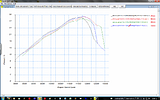Dont get hung up on Bl - STA, thinking its good to get rid of the transfer blip..
Any well developed race engine is ultimately Blowdown restricted, and you will always see the Tr Port pressure ratio rise when they open.
That effect is what makes port stagger work.
The first port to open, initially has backflow, it must, as there is more pressure above than below.
Then the rest of the ports open and eventually begin to flow into the cylinder due to the depression created by the pipe diffuser.
Thus the port that opens first, flows last.
Counter intuitive, but reality, proven on motored, instrumented engines in the lab and reported in a raft of SAE papers - and now shown in the sim.
Getting a balance between the blowdown needed to achieve the power you want, and the transfer area available is the tuning trick most valuable.
Superposition at ExPort opening is loosely referred to as pipe/port resonance, and is best achieved over the widest range with low Ex durations down at 192*.
Unfortunately this is countered by needing alot more blowdown than these numbers allow, and around 198 is needed to achieve the best bmep numbers.
In this scenario we try to achieve resonance at peak and beyond, to give plenty of overev power.
Next issue that is my favorite hobby horse for today is Ex duct exit area.
You will find a heap of free power, when using a T port or a Tripple port configuration, by limiting the duct exit area to around 75% of the Total Ex Port Effective.
Then make the header start at the area = to the Total Effective.
Join these with an oval to round adapter in the spigot or flange, where the width = the header dia all the way thru, to enhance the flow from the blowdown area,and
the height at the flange face forms an oval to give the correct 75% area.
The Temp Av in the pipe should be around 500 as in any fast engine you would measure around 600 in the header.
The TuMax should be around 1000,any more and you get deto, alot less and it means the temp/pressure rise in the chamber isnt high enough, and you are restricting the "push" on the piston.
But can also mean that you are using retarded timing to get heat into the pipe, not create pressure on the piston.
Lots more stuff, so little time.
Ive got a thing thats unique and new.To prove it I'll have the last laugh on you.Cause instead of one head I got two.And you know two heads are better than one.
Originally Posted by wobbly







 Reply With Quote
Reply With Quote








 - saying that duct volume should be as small as possible. Plus the quote of Jan's words earlier.
- saying that duct volume should be as small as possible. Plus the quote of Jan's words earlier.
Bookmarks